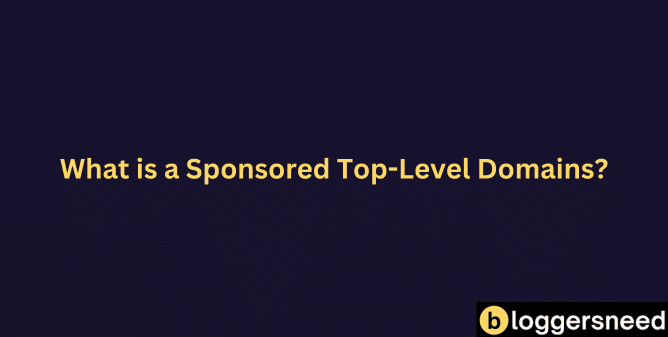
Sponsored Top-Level Domains (sTLDs) are specialized domain extensions managed by specific organizations, ensuring that only eligible entities within defined communities can register. These domains, such as .edu for accredited educational institutions and .gov for U.S. government agencies, enhance trust and credibility through strict regulations and unique identity representation. sTLDs serve specific communities or industries, establishing trust and credibility by indicating official and relevant information. For instance, .museum is for museum organizations, and .travel is for the travel industry. By using sTLDs, you can brand your online presence effectively, targeting your community and strengthening your online credibility. If you’re interested in learning more about how to acquire and benefit from sTLDs, you’ll find detailed insights just ahead.
Table of Contents
What is a Sponsored Top-Level Domain (sTLD)?
A Sponsored Top-Level Domain (sTLD) is a specialized type of top-level domain that’s supported and supervised by a specific organization or community.
These domain extensions are governed by strict regulations and policies set by their sponsors, ensuring that only eligible entities can register them. For example, the ‘.edu’ sTLD is reserved for accredited educational institutions in the United States, while ‘.gov’ is for U.S. government agencies.
sTLD governance is managed by the sponsoring organization, which determines the eligibility criteria and oversees the registration process through ICANN-accredited registrars.
This tight control helps maintain the integrity and trustworthiness of these domains, making them valuable for specific communities and industries.
The usage of sTLDs is highly restrictive, which can enhance their marketing value by instantly signaling the nature and credibility of the website.
What is the Purpose and What are the Characteristics of sTLDs?
The purpose of Sponsored Top-Level Domains (sTLDs) is to serve specific communities or industries by providing a domain that reflects their unique identity and adheres to strict eligibility criteria.
These domains are managed by sponsors who set and enforce the regulations, ensuring that only qualifying members of the community can register them.
The usage of sTLDs helps in establishing trust and credibility among users, as they indicate official and relevant information.
However, the limited number of sTLDs and strict eligibility criteria can present challenges for some applicants. Despite these, sTLDs maintain their popularity due to their ability to clearly identify the nature of the website.
What Are the Examples of sTLDs?
Examples of sTLDs include domains that cater to specific communities or industries, each with its own set of rules and eligibility criteria.
Listed below are the sponsored Top-Level Domains (sTLDs).
General sTLDs
- .aero – for the aviation industry
- .asia – for the Asia-Pacific region
- .coop – for cooperatives
- .edu – for accredited educational institutions (primarily in the U.S.)
- .gov – for U.S. government entities
- .int – for international organizations established by treaty
- .jobs – for employment-related websites
- .mil – for the U.S. military
- .museum – for museums
- .name – for personal names
- .post – for postal services
- .pro – for professionals (e.g., doctors, lawyers)
- .tel – for contact information
- .travel – for the travel industry
Industry-Specific sTLDs
- .bank – for verified banks and financial institutions
- .insurance – for the insurance industry
- .law – for legal professionals and organizations
- .pharmacy – for licensed pharmacies
Geographic and Community-Based sTLDs
- .cat – for the Catalan language and culture
- .jobs – for job-related websites
- .xxx – for adult entertainment sites
Other Notable sTLDs
- .charity – for charitable organizations
- .health – for health-related entities
- .info – for informational website
What are the Benefits of sTLDs?
When you use a sponsored top-level domain (sTLD), you gain several benefits that can improve your online presence and trustiness. sTLDs offer branding advantages, as they’re often associated with specific organizations or communities, allowing for a stronger brand identity. For instance, the .google TLD is exclusively used by Google, reinforcing their brand.
sTLDs also facilitate niche targeting, enabling organizations to cater to specific communities or regions. This can lead to community engagement, as the domain clearly indicates the target audience.
Additionally, using an sTLD like .edu or .gov can enhance trust, as these domains are restricted to legitimate educational or government entities.
How to Buy sTLDs Domain Extension from Domain Register?
To acquire a sponsored top-level domain (sTLD) domain extension, you must follow a specific process due to the regulatory nature of these domains. The buying process involves meeting the registration requirements set by the sponsoring organization, which can include eligibility criteria based on community themes or specific industries.
First, you need to check if you meet the eligibility criteria for the desired sTLD. For example, the .edu sTLD is limited to higher educational institutions.
Once you are eligible, you can proceed with the registration process, which typically involves submitting an application to a domain registrar and paying the associated domain pricing fees. These fees can vary significantly from one sTLD to another, and you should also take renewal fees into account to maintain your domain.
The application timeline can be lengthy due to the need for verification and approval by the sponsoring organization.
It’s essential to research and understand all aspects of the registration process before initiating the application.
What Is the Difference Between stlds and gtlds?
Sponsored top-level domains (sTLDs) and generic top-level domains (gTLDs) serve different purposes and operate under different regulatory frameworks.
The below table summarizes the key differences between sTLDs and gTLDs, highlighting their definitions, management, registration processes, and examples.
| Feature | Sponsored Top-Level Domains (sTLDs) | Generic Top-Level Domains (gTLDs) |
|---|---|---|
| Definition | Domains backed by specific organizations or communities. | Domains that are open for registration by anyone. |
| Sponsorship | Managed by a sponsoring organization that sets policies. | Managed by ICANN, with no specific sponsorship. |
| Registration | Restricted to specific communities or groups. | Open to the general public without restrictions. |
| Examples | .edu, .gov, .mil, .museum | .com, .net, .org, .info, .xyz |
| Purpose | To serve specific communities or industries. | To provide a generic domain option for any purpose. |
| Policy Control | Policies are determined by the sponsoring organization. | Policies are determined by ICANN and registry operators. |
| Eligibility Requirements | Must meet specific criteria set by the sponsor. | Generally, no specific eligibility requirements. |
Affiliate Disclosure: Some of the links in this post are affiliate links, which means I may earn a small commission if you make a purchase through those links. This comes at no extra cost to you. Thank you for your support!
